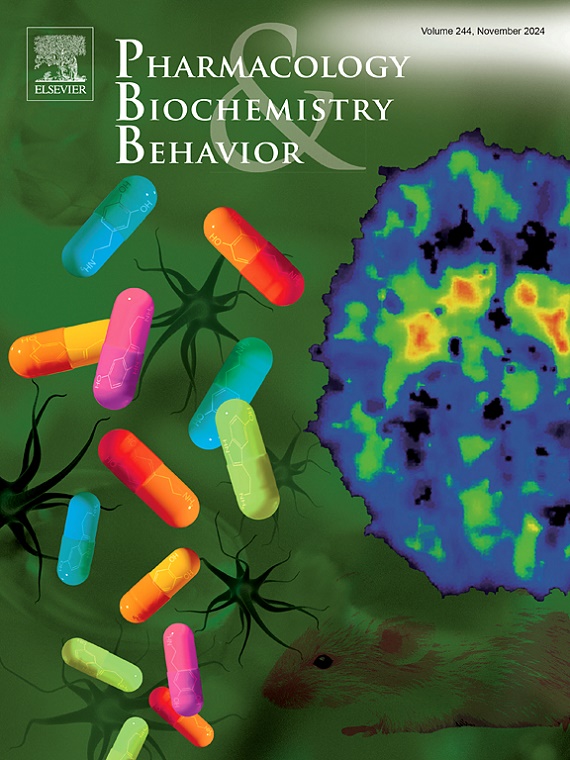果蝇抑郁样行为模型:外部应激参数和内在易感性的系统研究
IF 3.3
3区 心理学
Q1 BEHAVIORAL SCIENCES
引用次数: 0
摘要
目前,果蝇被广泛用于研究脑部疾病。遗憾的是,果蝇仍然缺乏一个成熟稳定的抑郁症研究模型。本研究针对这一问题,系统探讨了可能影响应激诱导模型建立和可重复性的外部应激和内在易感因素(果蝇品系、成虫/幼虫形态)。在此基础上,对参数进行了优化。结果表明,果蝇品系和形态是影响模型建立的关键因素,而外部应激则是影响模型死亡率的主要原因。与其他四个品系相比,Canton-S最容易受到慢性不可预知温和应激(CUMS)的影响。与成虫相比,幼虫对外界压力的反应能力较低。参数变化在很大程度上影响了冷/热/饥饿应激的模型死亡率。随后通过面效、结构效和预测效评估进行的模型方法验证研究表明,该模型具有面效(神经行为差异)、结构效(果蝇大脑中神经递质的变化)和预测效(氟西汀治疗后的行为变化)。此外,与平面行为相比,果蝇的空间行为实验能提供更真实的活动模式,最大限度地减少解读果蝇横向运动时可能出现的误差,因此建议将这一指标纳入模型评估。本研究提出了一套建立和评估抑郁样行为模型的综合方法,为抑郁症发病机制的研究以及抗抑郁药物的筛选、疗效评估和机理研究提供了更大的便利。本文章由计算机程序翻译,如有差异,请以英文原文为准。
Drosophila model of depression-like behavior: systematic investigation of external stress parameters and intrinsic susceptibility
Currently, Drosophila is widely used to study brain diseases. Unfortunately, Drosophila still lacks a mature and stable model for research on depression. This study addressed this issue by systematically exploring external stress and intrinsic susceptibility factors (Drosophila strains, adult/larval forms) that may influence the establishment and reproducibility of the stress-induced model. On this basis, the parameters are optimized. The results indicate Drosophila strains and forms are critical factors influencing model establishment, while external stress is the primary cause affecting the model's mortality rate. Compared with the other four strains, Canton-S are the most susceptible to chronic unpredictable mild stress (CUMS). Larval forms exhibit lower reactivity to external stress compared to adults. Parameter variations greatly influence model mortality rates from cold/heat/starvation stress. The model methodology validation study conducted subsequently through assessments of face, construct, and predictive validity demonstrates that the model exhibits face (neurobehavioral differences), structural (neurotransmitter changes in the Drosophila brain), and predictive (behavioral changes after fluoxetine treatment) validity. Additionally, spatial behavior experiments in Drosophila provide more realistic activity patterns compared to planar behavior, minimizing potential errors in interpreting lateral movements of the Drosophila, and it is recommended that this metric be included in model evaluation. This study presents a comprehensive set of methods for establishing and evaluating a depression-like behavior model and offers greater convenience for research on the pathogenesis of depression, as well as the screening, efficacy evaluation, and mechanistic studies of antidepressant drugs.
求助全文
通过发布文献求助,成功后即可免费获取论文全文。
去求助
来源期刊
CiteScore
6.40
自引率
2.80%
发文量
122
审稿时长
38 days
期刊介绍:
Pharmacology Biochemistry & Behavior publishes original reports in the areas of pharmacology and biochemistry in which the primary emphasis and theoretical context are behavioral. Contributions may involve clinical, preclinical, or basic research. Purely biochemical or toxicology studies will not be published. Papers describing the behavioral effects of novel drugs in models of psychiatric, neurological and cognitive disorders, and central pain must include a positive control unless the paper is on a disease where such a drug is not available yet. Papers focusing on physiological processes (e.g., peripheral pain mechanisms, body temperature regulation, seizure activity) are not accepted as we would like to retain the focus of Pharmacology Biochemistry & Behavior on behavior and its interaction with the biochemistry and neurochemistry of the central nervous system. Papers describing the effects of plant materials are generally not considered, unless the active ingredients are studied, the extraction method is well described, the doses tested are known, and clear and definite experimental evidence on the mechanism of action of the active ingredients is provided.

 求助内容:
求助内容: 应助结果提醒方式:
应助结果提醒方式:


